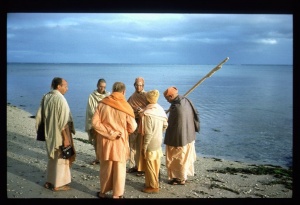CC Madhya 12.61

A.C. Bhaktivedanta Swami Prabhupada
TEXT 61
ei-mahā-bhāgavata, yāṅhāra darśane
vrajendra-nandana-smṛti haya sarva-jane
SYNONYMS
ei—here is; mahā-bhāgavata—a first-class devotee; yāṅhāra darśane—by the sight of whom; vrajendra-nandana—of the son of the King of Vraja; smṛti—remembrance; haya—becomes; sarva-jane—for everyone.
TRANSLATION
“Here is a great devotee,” Śrī Caitanya Mahāprabhu said. “Upon seeing him, everyone can remember the Supreme Personality of Godhead, Kṛṣṇa, son of Mahārāja Nanda.”
PURPORT
In his Anubhāṣya, Śrīla Bhaktisiddhānta Sarasvatī Ṭhākura states that a materialist mistakenly accepts the body and mind as the source of material enjoyment. In other words, a materialist accepts the bodily conception of life. Śrī Caitanya Mahāprabhu did not regard the son of Mahārāja Pratāparudra with the idea that he was a materialist, being the son of a materialist. Nor did He consider Himself the enjoyer. Māyāvādī philosophers make a great mistake by assuming that the sac-cid-ānanda-vigraha (BS 5.1), the transcendental form of the Lord, is like a material body. However, there is no material contamination in transcendence, nor is there any possibility of imagining a spirituality in matter. One cannot accept matter as spirit. As indicated by the technical words bhauma ijya-dhīḥ (SB 10.84.13), materialistic Māyāvādīs imagine the form of God in matter, although according to their imagination, God is ultimately formless. This is simply mental speculation. Even though Śrī Caitanya Mahāprabhu is the Supreme Personality of Godhead, He placed Himself in the position of a gopī. He also accepted the King’s son directly as the son of Mahārāja Nanda, Vrajendra-nandana Hari. This is perfect vision according to the direction of the Vedic culture, as confirmed in Śrīmad Bhagavad-gītā: paṇḍitāḥ sama-darśinaḥ (BG 5.18). Such acceptance of the Absolute Truth according to Vaiṣṇava philosophy is explained in both the Muṇḍaka Upaniṣad (3.2.3) and the Kaṭha Upaniṣad (1.2.23) in the following words:
- nāyam ātmā pravacanena labhyo
- na medhayā na bahunā śrutena
- yam evaiṣa vṛṇute tena labhyas
- tasyaiṣa ātmā vivṛṇute tanūṁ svām
“The Supreme Lord is not obtained by expert explanations, by vast intelligence, nor even by much hearing. He is obtained only by one whom He Himself chooses. To such a person He manifests His own form.” The living entity is entangled in material existence due to his lack of such spiritual vision. Śrīla Bhaktivinoda Ṭhākura has sung in his Kalyāṇa-kalpataru: saṁsāre āsiyā prakṛti bhajiyā ‘puruṣa’ abhimāne mari. When the living entity comes to the material world, he thinks himself the enjoyer. Thus he becomes more and more entangled.